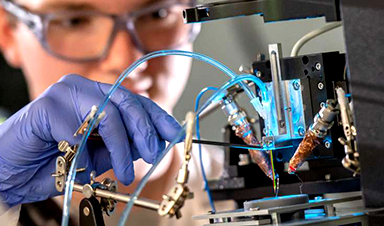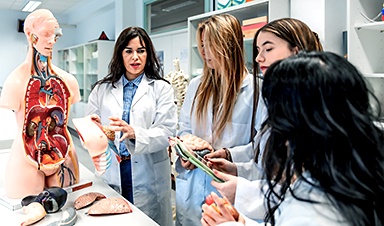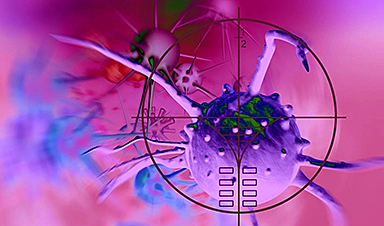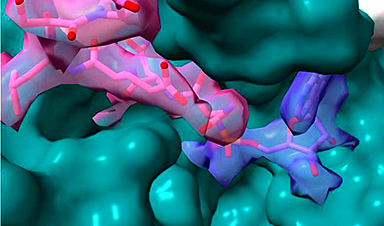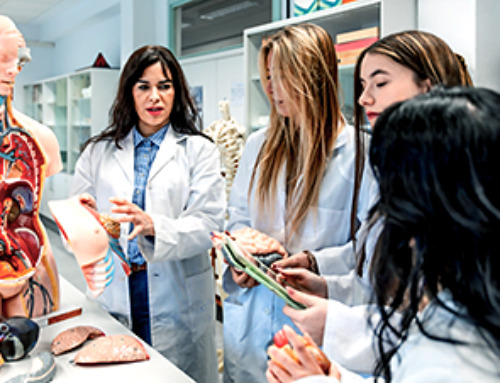It takes chemist Liaisan Khasanova less than a minute to turn an ordinary silica glass tube into a printing nozzle for a very special 3D printer. The chemist inserts the capillary tube—which is just one millimeter thick—into a blue device, closes the flap and presses a button. After a few seconds there is a loud bang and the nozzle is ready for use.
Khasanova and her colleagues need the minuscule nozzles to print incredibly tiny three-dimensional metallic structures. This means the nozzles’ openings must be equally tiny—in some cases so small that only a single molecule can squeeze through. “We are trying to take 3D printing to its technological limits,” says Dr. Dmitry Momotenko, who leads the junior research group at the Institute of Chemistry. His goal: “We want to assemble objects atom by atom.”
Numerous applications
Nanoscale 3D printing—in other words 3D printing of objects that are a just few billionths of a meter in size—opens up amazing opportunities, the chemist explains. For metal objects in particular, he can envisage numerous applications in areas such as microelectronics, nanorobotics, sensor and battery technology: “Electroconductive materials are needed for all kinds of applications in these areas, so metals are the perfect solution.”
While 3D printing of plastics has already advanced into these nanoscale dimensions, manufacturing tiny metal objects using 3D technology has proven more difficult. With some techniques the printed structures are still a thousand times too large for many advanced applications, while with others it is impossible to fabricate the objects with the necessary degree of purity.
Momotenko specializes in electroplating, a branch of electrochemistry where metal ions suspended in a salt solution are brought into contact with a negatively charged electrode. The positively charged ions combine with electrons to form neutral metal atoms which are deposited on the electrode, forming a solid layer.
“A liquid salt solution becomes a solid metal—a process which we electrochemists can control very effectively,” says Momotenko. This same process is used for chrome-plating car parts and gold-plating jewelry on a larger scale.
A little smaller than usual
However, transferring it to the nanoscopic scale requires considerable ingenuity, effort and care, as a visit to the group’s small laboratory on the university’s Wechloy campus confirms. The lab contains three printers—all built and programmed by the team itself, as Momotenko points out. Like other 3D printers they consist of a print nozzle, tubes for feeding in the print material, a control mechanism and the mechanical components for moving the nozzle—but in these printers everything is a little smaller than usual.
A colored saline solution flows through delicate tubes into the thin capillary tube, which in turn contains a hair-thin piece of wire—the anode. It closes the circuit with the negatively polarized cathode, a gold-plated silicon flake smaller than a fingernail, which is also the surface on which the printing takes place. Micromotors and special crystals that morph instantaneously when an electrical voltage is applied rapidly move the nozzle by fractions of a millimeter in all three spatial directions.
Since even the slightest vibrations can disrupt the printing process, two of the printers are housed in boxes covered in a thick layer of dark-colored acoustic foam. Furthermore, they are resting on granite plates, each weighing 150 kilograms. Both measures are aimed at preventing unwanted vibrations. The lamps in the lab are also battery-powered because the electromagnetic fields produced by alternating current from a socket would interfere with the tiny electrical currents and voltages needed to control the nanoprinting process.
A trip into the nanoworld
Meanwhile, Liaisan Khasanova has prepared everything for a test print: the print nozzle is in its starting position, the box is closed, a vial containing a light blue copper solution is connected to the tubes. She starts a program which initiates the printing process. Measurement data appears on a screen as curves and dots. These show the variations in the current flow and register the nozzle briefly touching the substrate and then retracting again and again. What is the machine printing? “Just a few columns,” she replies.
Columns are the simplest geometric forms generated in 3D printing, but the Oldenburg researchers can also print spirals, rings and all kinds of overhanging structures. The technique can currently be used to print with copper, silver and nickel, as well as nickel-manganese and nickel-cobalt alloys. In some of their experiments, they have already ventured deep into the nanoworld. Momotenko and an international team of researchers reported in a study published in the journal Nano Letters in 2021 that they had produced copper columns with a diameter of just 25 nanometers—taking 3D metal printing below the 100-nanometer limit for the first time.
One of the cornerstones for this success was a feedback mechanism that enables precision control of the print nozzle’s movements. It was developed by Momotenko together with Julian Hengsteler, a Ph.D. student he supervised at his previous place of work, ETH Zurich in Switzerland. “The continuous retraction of the print nozzle is enormously important, because otherwise it would quickly become clogged,” explains the chemist.
“A liquid salt solution becomes a solid metal—a process which we electro-chemists can control very effectively.”
The team prints the tiny objects layer by layer at speeds of a few nanometers per second. Momotenko still finds it amazing that objects too small to be visible to the human eye are being created here. “You start with an object you can touch. Then a certain transformation takes place and you are able to control these invisible things at an extremely small scale—it is almost unbelievable,” says the chemist.
An e-car might be charged within seconds
Momotenko’s plans for his nanoprinting technique are also pretty mind-boggling: his goal is to lay the foundations for batteries that can be charged a thousand times faster than current models. “If that can be achieved, you could charge an e-car within seconds,” he explains. The basic idea he is pursuing is already around 20 years old. The principle is to drastically shorten the pathways of the ions inside the battery during the charging process.
To do this, the electrodes, which are currently flat, would have to have a three-dimensional surface structure. “With the current battery design, charging takes so long because the electrodes are relatively thick and far apart,” Momotenko explains.
The solution, he says, is to interlock the anodes and cathodes like fingers at the nanoscale and reduce the distance between them to just a few nanometers. This would allow the ions to move between anode and cathode at lightning speed. The problem: so far it has not been possible to produce battery structures with the required nano dimensions.
Momotenko has now taken on this challenge. In his NANO-3D-LION project, where the goal is to develop and employ advanced nanoscale 3D printing techniques to fabricate active battery materials with ultrasmall structural features. Having collaborated successfully with a research group led by Prof. Dr. Gunther Wittstock at the Institute of Chemistry in an earlier project, Momotenko then decided to base the project at the University of Oldenburg. “The Department for Research and Transfer was very helpful with my grant application, so I moved here from Zurich at the beginning of 2021,” he explains.
His research group now has four members: besides Khasanova, Ph.D. student Karuna Kanes and Master’s student Simon Sprengel have joined the team. Kanes focuses on a new method aimed at optimizing the precision of the print nozzle, while Sprengel investigates the possibility of printing combinations of two different metals—a process necessary to produce cathode and anode material simultaneously in one step.
Liaisan Khasanova will soon focus on lithium compounds. Her mission will be to find out how the electrode materials currently used in lithium batteries can be structured using 3D printing. The team is planning to investigate compounds such as lithium-iron or lithium-tin, and then to test how large the nano “fingers” on the electrode surfaces need to be, what spacing is feasible, and how the electrodes should be aligned.
Handling highy reactive lithium
One major hurdle here is that lithium compounds are highly reactive and can only be handled under controlled conditions. For this reason, the team recently acquired an extra-large version of a laboratory glove box, a gas-tight sealed chamber that can be filled with an inert gas such as argon. It has handling gloves built into one side with which the researchers can manipulate the objects inside.
The chamber, which is about three meters long and weighs half a ton, is not yet in operation, but the team plans to set up another printer inside it. “The chemical conversion of the material and all other tests will also have to be carried out inside the chamber,” Momotenko explains.
The team will run up against some major questions in the course of the project: How do tiny impurities within the argon atmosphere affect the printed lithium nanostructures? How to dissipate the heat that is inevitably generated when batteries are charged within seconds? How to print not just tiny battery cells but also large batteries for powering a mobile phone or even a car—within a reasonable time?
“On the one hand, we are working on the chemistry needed to produce active electrode materials at the nanoscale; on the other, we are trying to adapt the printing technology to these materials,” says Momotenko, outlining the current challenges.
The problem of energy storage is extremely complex, and his team can only play a small part in solving it, the researcher emphasizes. Nonetheless, he sees his group in a good starting position: in his opinion, electrochemical 3D printing of metals is currently the only viable option for manufacturing nanostructured electrodes and testing the concept.
In addition to battery technology, the chemist is also working on other bold concepts. He wants to use his printing technique to produce metal structures that allow for a more targeted control of chemical reactions than possible so far. Such plans play a role in a relatively young field of research known as spintronics, which focuses on the manipulation of “spin”—a quantum mechanical property of electrons.
Another idea he hopes to put into practice is to manufacture sensors that are able to detect individual molecules. “That would be helpful in medicine, for detecting tumor markers or biomarkers for Alzheimer’s at extremely low concentrations, for example,” says Momotenko.
All these ideas are still very new approaches in chemistry. “It is not yet clear how it would all work,” he admits. But that’s how it is in science: “Every meaningful research project requires long thinking and planning, and in the end most ideas fail,” he concludes. But sometimes they don’t—and he and his team have already taken the first successful steps on their journey.
News
New Once-a-Week Shot Promises Life-Changing Relief for Parkinson’s Patients
A once-a-week shot from Australian scientists could spare people with Parkinson’s the grind of taking pills several times a day. The tiny, biodegradable gel sits under the skin and releases steady doses of two [...]
Weekly injectable drug offers hope for Parkinson’s patients
A new weekly injectable drug could transform the lives of more than eight million people living with Parkinson's disease, potentially replacing the need for multiple daily tablets. Scientists from the University of South Australia [...]
Most Plastic in the Ocean Is Invisible—And Deadly
Nanoplastics—particles smaller than a human hair—can pass through cell walls and enter the food web. New research suggest 27 million metric tons of nanoplastics are spread across just the top layer of the North [...]
Repurposed drugs could calm the immune system’s response to nanomedicine
An international study led by researchers at the University of Colorado Anschutz Medical Campus has identified a promising strategy to enhance the safety of nanomedicines, advanced therapies often used in cancer and vaccine treatments, [...]
Nano-Enhanced Hydrogel Strategies for Cartilage Repair
A recent article in Engineering describes the development of a protein-based nanocomposite hydrogel designed to deliver two therapeutic agents—dexamethasone (Dex) and kartogenin (KGN)—to support cartilage repair. The hydrogel is engineered to modulate immune responses and promote [...]
New Cancer Drug Blocks Tumors Without Debilitating Side Effects
A new drug targets RAS-PI3Kα pathways without harmful side effects. It was developed using high-performance computing and AI. A new cancer drug candidate, developed through a collaboration between Lawrence Livermore National Laboratory (LLNL), BridgeBio Oncology [...]
Scientists Are Pretty Close to Replicating the First Thing That Ever Lived
For 400 million years, a leading hypothesis claims, Earth was an “RNA World,” meaning that life must’ve first replicated from RNA before the arrival of proteins and DNA. Unfortunately, scientists have failed to find [...]
Why ‘Peniaphobia’ Is Exploding Among Young People (And Why We Should Be Concerned)
An insidious illness is taking hold among a growing proportion of young people. Little known to the general public, peniaphobia—the fear of becoming poor—is gaining ground among teens and young adults. Discover the causes [...]
Team finds flawed data in recent study relevant to coronavirus antiviral development
The COVID pandemic illustrated how urgently we need antiviral medications capable of treating coronavirus infections. To aid this effort, researchers quickly homed in on part of SARS-CoV-2's molecular structure known as the NiRAN domain—an [...]
Drug-Coated Neural Implants Reduce Immune Rejection
Summary: A new study shows that coating neural prosthetic implants with the anti-inflammatory drug dexamethasone helps reduce the body’s immune response and scar tissue formation. This strategy enhances the long-term performance and stability of electrodes [...]
Scientists discover cancer-fighting bacteria that ‘soak up’ forever chemicals in the body
A family of healthy bacteria may help 'soak up' toxic forever chemicals in the body, warding off their cancerous effects. Forever chemicals, also known as PFAS (per- and polyfluoroalkyl substances), are toxic chemicals that [...]
Johns Hopkins Researchers Uncover a New Way To Kill Cancer Cells
A new study reveals that blocking ribosomal RNA production rewires cancer cell behavior and could help treat genetically unstable tumors. Researchers at the Johns Hopkins Kimmel Cancer Center and the Department of Radiation Oncology and Molecular [...]
AI matches doctors in mapping lung tumors for radiation therapy
In radiation therapy, precision can save lives. Oncologists must carefully map the size and location of a tumor before delivering high-dose radiation to destroy cancer cells while sparing healthy tissue. But this process, called [...]
Scientists Finally “See” Key Protein That Controls Inflammation
Researchers used advanced microscopy to uncover important protein structures. For the first time, two important protein structures in the human body are being visualized, thanks in part to cutting-edge technology at the University of [...]
AI tool detects 9 types of dementia from a single brain scan
Mayo Clinic researchers have developed a new artificial intelligence (AI) tool that helps clinicians identify brain activity patterns linked to nine types of dementia, including Alzheimer's disease, using a single, widely available scan—a transformative [...]
Is plastic packaging putting more than just food on your plate?
New research reveals that common food packaging and utensils can shed microscopic plastics into our food, prompting urgent calls for stricter testing and updated regulations to protect public health. Beyond microplastics: The analysis intentionally [...]
